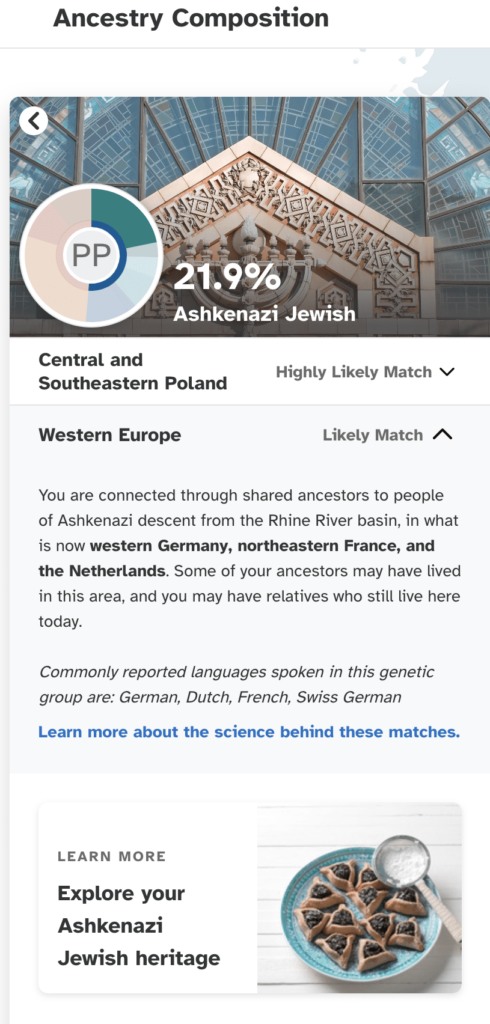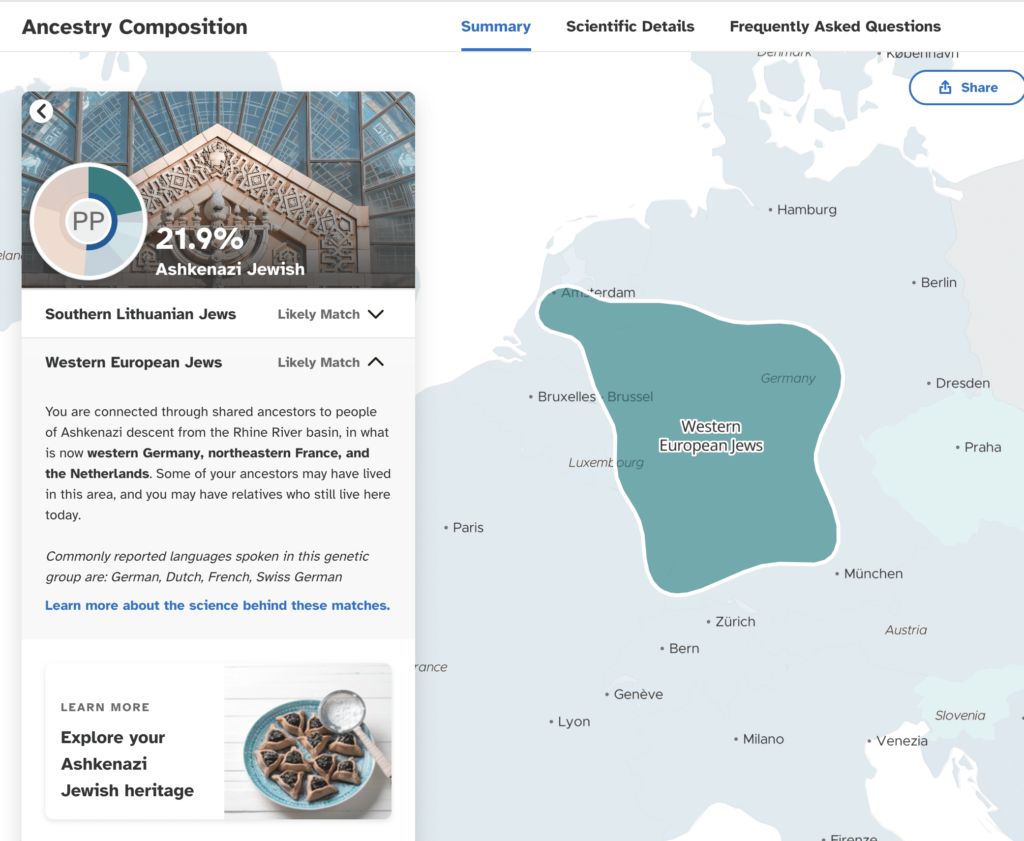In the latest update to 23andMe’s Ancestry Reports and features, we’ve added finer detail for customers with Ashkenazi Jewish ancestry, allowing them to trace their family connections back to seven genetic groups corresponding to regions within Eastern and Central Europe.
Some of these regions overlap, but they map to areas with deep historical and cultural significance for people of Ashkenazi ancestry. The long history of pogroms, persecution, and the devastating horror of the Holocaust annihilated the connections of many of those with Ashkenazi ancestry to their families’ historical origins. DNA testing has the potential to offer hints to those connections where family history may be lacking.
That is partly the purpose of this update, to offer customers with Ashkenazi ancestry a deeper connection to those historical regions and cultural connections.

What is Ashkenazi Jewish ancestry?
People with Ashkenazi ancestry are connected to Jews who settled in Central and Eastern Europe during the Middle Ages. The word “Ashkenazi” is thought to come from the name Ashkenazi, a descendant of Noah in the Hebrew bible.
During their long history in Europe, Ashkenazi Jews faced persecution and cultural isolation that, in turn, impacted their genetics. Starting in the 11th century, Jews living in Europe began to experience intense persecution, which eventually led to their expulsion from many countries. This, along with the plague that hit Europe in the 14th and 15th centuries, decimated the Jewish population, which plummeted by close to 90 percent.
Those forces that isolated the population and drastically reduced its size created what genetics called a “population bottleneck.” Bottlenecks can be caused by geographic barriers, disease, migration, or persecution isolating a population over generations. That is what happened among Ashkenazi Jewish communities of Central and Eastern Europe.
Scientists think that, because of this bottleneck, the 10 million Ashkenazi Jews who are alive today have descended from just a few hundred founding individuals. Interestingly, their modern descendants remain genetically more similar to other Jewish populations than their European neighbors. In the twentieth century, amidst two World Wars and the Holocaust, and after the war years, many Ashkenazi Jews immigrated to what is now Israel or to the Americas in search of greater cultural and religious acceptance. Today, over five million ethnic Ashkenazi Jews live in the U.S.

Ancestry composition update
23andMe’s Ancestry Composition report is a living analysis that improves as we add new reference data. Underlying our Ancestry reports are powerful algorithms and analytical tools developed by 23andMe population geneticists and engineers to offer our customers more insights into their ancestral origins. Over the last few years, we’ve updated results for people with African Ancestry, Chinese ancestry, Indigenous American ancestry, and Latinx ancestry, for instance.
In this update, the new methodology and algorithms use data from groups of people of Ashkenazi ancestry with four grandparents from specific regions in Central and Eastern Europe. We can connect customers with Ashkenazi ancestry to those regional genetic groups through their shared DNA.
Ashkenazi Jewish genetic groups
Almost all of our customers on the latest genotyping chip, V5, who have more than 90 percent Ashkenazi ancestry, will receive at least one match to one of those genetic groups. This means they share high genetic similarity with people in that genetic group. About 80 percent of our customers on the latest chip with more than 75 percent Ashkenazi ancestry will receive a match. About 900,000 customers with Ashkenazi ancestry will receive a match to one of these regional genetic groups. While customers may receive a likely or highly likely match to one of these genetic groups, this update does not provide a more detailed breakdown of customers’ Ashkenazi Jewish ancestry percentage.
While some regions overlap, we’ve distinguished each geographically and descriptively. The names of these clusters also attempt to indicate the geographic areas.
The clusters include:
- Belarusian Jews — this region aligns with Belarus.
- Lithuanian Jews — this region includes Lithuania, Latvia, and Belarus.
- Western European Jews —this region includes southwestern Germany, as well as the Netherlands near the Rhine River.
- Southeastern Polish Jews — this region overlaps with southeastern Poland.
- Eastern Polish and Western Ukrainian Jews — this region includes eastern Poland and western Ukraine.
- West Central Ukrainian Jews, — this region includes west-central Ukraine.
- Central European and Western Ukrainian Jews — this region includes western Ukraine, Hungary, Romania, and Slovakia.

Your ancestry matters for your health
While this update provides essential connections for customers with Ashkenazi ancestry, it also offers the opportunity to remind people that their ancestry matters for their health, too.
In the case of people with Ashkenazi ancestry, their unique history, which led to their isolation, also had genetic implications. People with Ashkenazi ancestry are more likely to carry genetic variants that cause certain single-gene recessive Mendelian conditions such as Gaucher disease, Canavan disease, and Tay-Sachs disease. In addition, people with Ashkenazi ancestry are more likely to carry the so-called “founder variants” in the BRCA1 and BRCA2 that increase the risk of breast, ovarian, and prostate cancer.
Find out more
With more than 2,000 geographic regions, mitochondrial and Y-chromosome haplogroups, Ancestry Timeline, advanced DNA comparison, DNA Relatives, and a genetic Family Tree, 23andMe offers more specificity, more interactivity, and more to explore. 23andMe’s Ancestry Composition improves over time as 23andMe adds new populations and regions, offering customers a chance to see more granularity in their results.
23andMe customers can go to their Ancestry Overview to start exploring.
Not yet a customer? Find out more about 23andMe’s ancestry offerings here.